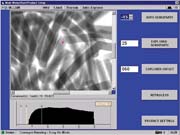
An assistant vice president with Costco Wholesale Corp. in Issaquah, WA, Wilson heads the club stores' food safety department. Last summer, he fired off a letter to Costco's food suppliers, "challenging our vendors to consider adopting X-ray inspection, which is 40-year-old technology at this point," Wilson recounts. "We now require metal detectors. We will soon require X-ray."
In the past, small and mid-sized food manufacturers have won supply contracts with major retailers by installing X-ray units. The Costco letter sets the stage for manufacturers to lose key customers because they were reluctant to embrace the technology. It also raises concern that companies may succumb to hyperbole about the technology's capabilities. "There's still some homework to be done by the Costco guys on what X-ray can and cannot do," cautions Wyeth Thomas, sales manager for the Safeline division of Mettler-Toledo Inc. "For now, they're making small suppliers nervous."
Less costly and more reliable components are helping to make automated X-ray inspection faster, more compact and more affordable, though hardware improvements pale in comparison to software advances. As engineers zero in on the gray-scale subtleties of a particular food and potential contaminants, they are able to write more powerful algorithms to screen products in a high-speed environment. The more homogenous the product, the more likely an X-ray system can detect objects of a different density. And as computational power increases, X-ray inspection is taking on additional quality-assurance responsibilities, such as checkweighing, content validation and fat analysis.
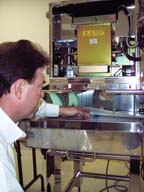
When it comes to checkweighing functionality, Fleps counts himself among the technology's skeptics. Using sophisticated calculations based on grayscale measurements of an object, suppliers such as Smiths Detection maintain their X-ray units can replace end-of-line checkweighers. Mass changes of one to two percent are detectable, allows Fleps, but he insists X-ray hasn't achieved the precision of checkweighers, at least not yet.
Nonetheless, the technology is improving rapidly, and its acceptance in Europe and Japan will compel world-class manufacturers to incorporate it in North American plants. As end-users' understanding of the potential and limitations of X-ray increases, the likelihood of successful implementations will increase.
19th Century technology
Ionizing radiation was observed in 1895 by Wilhelm Roentgen, who coined the word X-ray. More than 50 years later, the food industry began dabbling with X-rays, according to Allan Anderson, president of Fremont, CA-based InspX LLC, a joint venture between Key Technology and Peco Controls. Anderson recalls introducing a fill-level inspection system using radioactive isotopes in the late 1970s, and the low cost and reliability of that system soon supplanted competing X-ray units.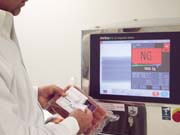
Baby food manufacturers sparked renewed interest in X-ray in the 1990s. Detecting miniscule glass fragments in a glass jar is a challenge that can be overcome with multiple X-rays and large amounts of capital. Canned food producers like H.J. Heinz and Campbell Soup also spurred X-ray inspection, given a metal detector's ineffectiveness in metal can inspection. Expanded use of metalized film in food packaging is creating another group of potential X-ray users.
Peco began development of X-ray units as a replacement for isotopes in fill-level measurement a decade ago, says Anderson. "A new engineer we hired suggested inspecting the whole package, so we began developing a system that could match production speeds, was washdown-ready and could be monitored remotely," he says. "We shipped our first unit to a cannery in Salinas, CA, five years ago, and we've never had to go down there. Calibration and troubleshooting can all be done on line."
While prices have declined significantly, X-ray remains a costly alternative to metal detectors. Consequently, some manufacturers have applied X-ray inspection to cases of finished goods. The result is less than optimum performance. "People want X-ray to do all sorts of things, but you run up against the laws of physics," Anritsu's Willems observes.
As with most technologies, tradeoffs must be made between capabilities and performance. For example, the smaller the X-ray zone, the greater the detection capabilities; as the zone expands, performance declines. Similarly, foreign particles as small as 0.2 mm are detectable, but optimum sensitivity also means more false positives and higher reject rates. With faster processing speed, smaller diode arrays and more sophisticated algorithms, X-ray is performing more tasks with greater reliability. Nonetheless, experts caution, X-ray is not a silver bullet. "Sometimes, X-ray will not outperform a metal detector," points out Safeline's Thomas. Adds Bob Ries, Minneapolis-based contaminant detection product manager at Thermo Electron, "X-ray has good and bad applications, the same as metal detectors."
Tampa, FL-based Safeline has made a number of hardware improvements in recent years to improve the sensitivity of its X-ray units, such as diode arrays that detect objects down to 0.4 mm in diameter, "with zero false positives," Thomas claims. An image storage system, open-network communications protocols and upgradeable operating base are other improvements. As with all X-ray vendors, Safeline's point of distinction is its software, and five years ago the company acquired AVS (Analytical Vision Systems), which had written programs for several X-ray inspection firms. "We have three men with more than 100 years experience in the food industry, constantly refining our algorithms," Thomas says.
He also disputes X-ray's ability to compete with checkweighers in a high-volume environment. But multifunctionality is central to the technological message of Smiths Detection, and weight verification not only is doable, it's being done, insists Dick Wyman, applications manager for the Alcoa, TN, firm.
"We write tools that look for differences in thickness and density of an object, and it's a straightforward computation of density times thickness plus area to determine the weight," says Wyman. Adding weight verification to density analysis doesn't make an X-ray machine break a sweat: "checkweighing and contamination analysis gets us to 18 percent of our processing capacity," he says.
Some suppliers give high marks to X-ray's weight-computation capability. "It's more of a validation tool at this point," Anritsu's Willems believes, "but in the future, Smiths will rival our checkweighers, which are accurate to within, in some cases, 0.002 grams."
Wyman was one of the founders of Smiths in 1998, and although Smiths is one of the newer food X-ray suppliers, its focus on food inspection has made it one of the largest North American X-ray suppliers. Specialization has allowed Smiths to develop applications for specific situations. For example, simple geometry was deployed for case inspection of snack food in paper bags: by angling the source beam at 15 degrees, "the beam only had to go through an eighth of an inch of cardboard instead of 8 inches," he explains. Less material means greater image resolution and therefore superior detection.
Smiths' machines can detect particles of stainless steel down to 0.8 mm, about half the specified size limit when its first machines were deployed. Rather than push the system to detect even more finite particles, the company's software engineers are focusing on "the tens of thousands of ways you can look at an image to do different things that are customer driven" says Wyman. "We don't see a need to get smaller than 0.8 mm" on the detection side.
Smaller is better from a Japanese perspective, and that's where Anritsu's roots are. The company dominates the inspection business in Japan, where X-ray machines in both manufacturing and retail stores are common. US operations commenced last year, in part because Japanese importers are pressuring exporters in the US and elsewhere to institute X-ray inspection.
Small size also is beneficial when trying to wedge an X-ray unit into an existing production line. Anritsu's basic machine measures 3-ft.-long, 33 in. wide and 56-in. tall. A Pentium 4 processor, video card and circuit board are mounted inside the cabinet, eliminating any racks or additional cabinetry. The power source runs on 210 watts, significantly lower than most X-rays and allows use of a lamp cooling system that doesn't involve oil and a heat exchanger.
Bones of contention
Thermo Electron debuted a seventh generation X-ray imaging system last spring. The field where the X-ray source and diodes interact with the product-commonly referred to as the tube-was adapted from medical applications to satisfy food's continuous inspection environment. It also represents a stripped down approach to X-ray inspection to bring the technology more in line with what food processors spend on metal detectors.The entry-level unit joins three other models in Thermo's lineup, including a pipeline version used to detect bone. The X-ray often is used to screen pieces of chicken as they are pumped through a 3-4 in. diameter pipe, Ries says. Other systems are being applied to boneless chicken breast.
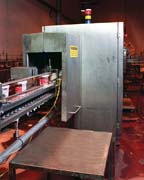
The same problem befuddles every other X-ray supplier. "In theory X-ray has the capability to detect poultry bones, but there are a number of practical problems," says Smiths' Wyman: besides the density of the bone, boneless chicken breasts typically are overlapping in a conveyor, "and where that overlap occurs, the density looks exactly like a wishbone," he says.
Lack of calcification may be more related to the birds' diet than their age. "I have found smaller bones in 28-day-old South American chickens than in 56-day-old birds in the US," says Anritsu's Willems.
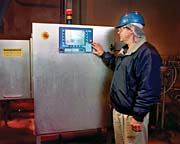
That said, X-ray technology pushes the envelope in quality assurance. Besides the potential for detecting rocks, wood, glass and other contaminants, manufacturers are discovering process-control benefits, once they learn to interpret what the machine is telling them. Willems cites an Atlanta pie manufacturer who discovered that a white area under the pie crust indicated a product void that resulted in uneven baking. It also meant the machine that perforated the crust before baking was gummed up with dough. Now when that X-ray image appears, operators know they must clean the perforation machine.
"Automation is driving a lot of X-ray deployment," observes InspX's Anderson. "When you take people out of the plant equation, you take out eyes and ears that used to notice when things went wrong. If you have to put a hold on everything produced since the last person walked by, you might have to embargo three days worth of production."
Vendors have touted X-ray's benefits for years, and the nudge from Costco may be enough to make it a mainstream tool. "It's wonderful technology, it appears to work, and food companies that don't adopt it are going to be looked on as second-class citizens," Costco's Wilson predicts. If it can also deliver benefits beyond contaminant detection, the business case for X-ray inspection will be easier to make.
For more information:
Jay Willems, Anritsu Industrial Solutions USA,
847-419-9729,
jwillems@us.anritsu-industry.com
Allan Anderson, InspX LLC,
510-226-6686,
anderson@inspx.com
Hermann Fleps, Loma Systems,
630-681-2058,
Wyeth Thomas, Mettler-Toledo Inc./Safeline,
813-889-9500
Dick Wyman, Smiths Detection,
865-379-1670
Bob Ries, Thermo Electron Corp.,
763-783-2600
Einar Einarsson, Marel USA Inc.,
913-888-9110,
einar@marelusa.com
